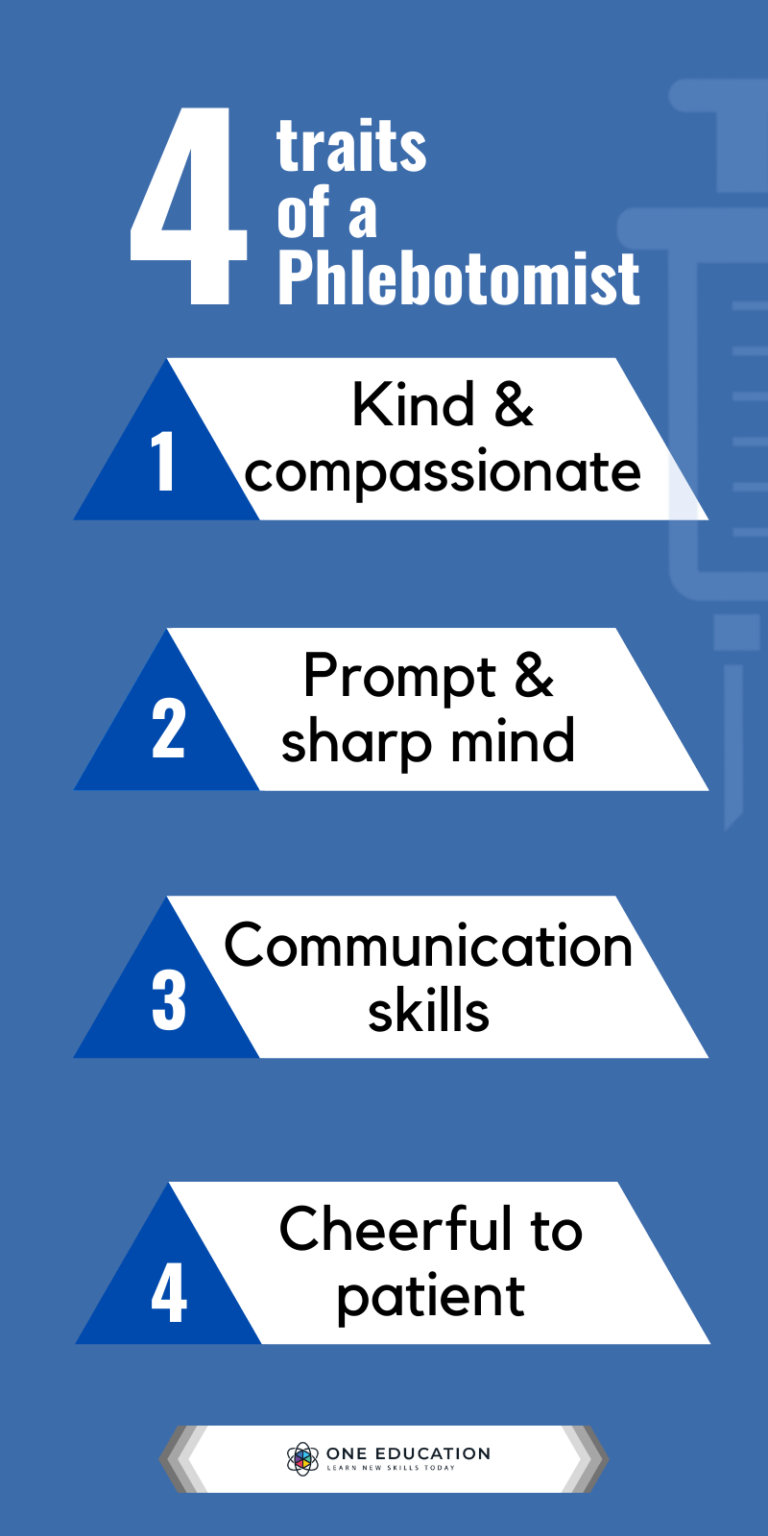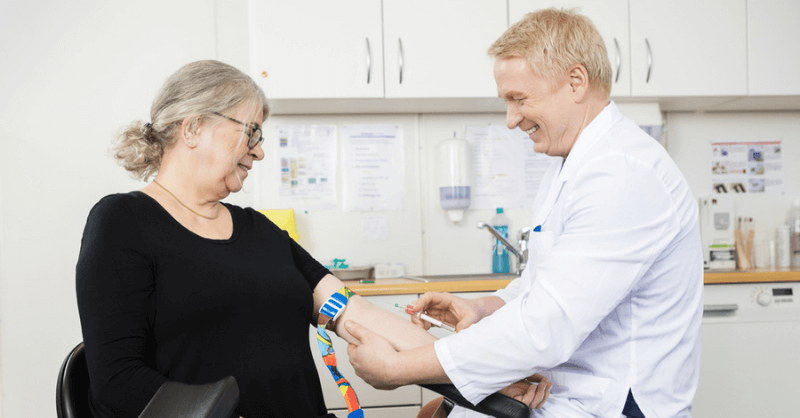Phlebotomy is one of the many crucial parts in the modern health care system. Absolutely every institution providing healthcare services employs Phlebotomists directly or indirectly. In this blog, we’ll talk about how you can become a Phlebotomist. Phlebotomy basically means “to draw blood” in most cases from veins. It is also known as Venipuncture, a procedure with solid scientific ground works.
However, it also requires human attention and precision to make it less intimidating. Dealing with patients or insurance clients depending on the professional setting. Moreover, Phlebotomists have to be committed to the services they provide.
Any organisation working with biological samples (mainly, diagnostic or research laboratories) depends on veteran Phlebotomists to ensure total success.
Table of Contents
Who is a Phlebotomist?
If you are an adult reading this you’ve probably met a phlebotomist or two by now, right? Phlebotomists are medical technicians. They are hired to collect blood samples directly from patients veins using hypodermic needles.
Phlebotomy requires mastery of eye hand coordination which is certainly attainable through dedication. Although, as a Phlebotomist you have to be tolerant to needles and blood since they will be your daily companions. Most importantly though, Phlebotomists need to talk to patients and donors about the procedures and tests, as well as about the concerns patients may have about Venipuncture.
What you need to become a Phlebotomist in the UK
Phlebotomy is a care oriented job requiring specialized training in combination with clear understanding of fundamental sciences such as Biology, Psychology and Mathematics. If you’re looking for a career opportunity in healthcare, phlebotomy could be your answer. However, you will need to present certification for your previous studies to become a Phlebotomist. The basic outline for pursuing Phlebotomists positions is as follows
1) A-levels or Equivalent Diploma
To participate in any sort of phlebotomy training, you must have completed highschool / A-levels. Without a diploma the next best thing is at least 2 GCSE certifications. Get any one of these credentials and start training programs for Phlebotomists. Remember, training programs are not required as prerequisite of enrolment in colleges. So, you can start almost as soon as you’re finished with high school. Moreover, you have to be a minimum of 18 years of age to enroll in any sort of vocational training.
2) Training
There are tons of programs available for Phlebotomist training. While some programs are offered by colleges, they usually have limited capacity. So, a number of independent organisations also provide training opportunities. However, having completed any of the following degrees will definitely give you a competitive edge.
Training can be divided into one or two semesters or, four to eight month long crash courses. You need to choose the one best suited for you. Theoretical courses involve Anatomy and Physiology, but the most important part is practical exercises and demonstrations that teach you the intricate details of drawing blood in the most efficient and friendliest way possible.
3) Certificate
Employers usually prefer candidates with formal certification and a number of the organisations provide you with certification on successful completion of a formal exam. Certificates ensure you get the legitimate pay while also ensuring reliable outputs for employers.
There are institutions such as the Phlebotomists Association in the UK which require accredited certificates to establish memberships. Alongside technical credentials you may also have to provide validated Immunological History to ensure safe protocols in critical care environments.
Learn more: How to Get your Phlebotomy Certification
4) Placement
Besides hospitals, a number of institutions hire Phlebotomists. They include diagnostic labs, research institutes, adult care homes etc. However, the role of a Phlebotomist varies very little among these settings. Phlebotomy is a practical profession and you will do most of the learning in a professional environment during your novice years.
You’ll probably have to practice on non-patient volunteers usually under a supervising Phlebotomist. Upon gathering enough experience you will get to work with actual patients. So, completing a training course is not enough without proper practice sessions at the job. Most employers support real life experience at work. If your papers are in order the job may as well be yours.
Related: Where Phlebotomists can work: All you need to know

Why become a Phlebotomist
Phlebotomy is one of the many direct patient handling professions. This will oftentimes put Phlebotomists in a demanding situation. For a Phlebotomist, the job is about helping people through a very necessary and sometimes discomforting procedure. Besides the technical demands, the work requires additional social skills which make the procedure comfortable for both patient and phlebotomist.
If you think you feel strongly about being in a profession where technicality is just as important as empathy then being a phlebotomist may just be your thing. The profession may provide travel opportunities if you happen to land a job at a donation campaign. In other cases you may be called in for emergencies in the middle of vacations. But that is just how valuable Phlebotomists are.
What to expect
1) Technical Details
Phlebotomy involves some basic yet essential work for healthcare industries. The technical aspect of the job can be summed up into, preparing and arranging blood drawing trays, verifying patient identity, labeling, preparing and transporting samples for processing alongside, entering relevant information accurately into the computer. Besides these duties a Phlebotomist must maintain safety and hygiene of the Phlebotomy equipment, and dispose of Phlebotomy waste products according to the national guidelines.
2) Work Environment
Phlebotomy is usually a full-time responsibility in medical and diagnostic laboratories, blood donation centres, medical facilities and private clinics. Currently, 55% of Phlebotomists in the UK are employed full time. Work environments in critical and emergency care units can be hectic so being efficient and accurate is a must even under pressure.
You will usually render the standard number of hours every week but depending on your responsibilities you may be asked to work on weekends or evenings on a shift basis. In large hospitals or in independent laboratories that operate continuously, Phlebotomists are needed in day, evening or night shifts and may work on weekends or holidays. You will also be required to have certain immunisation and comply with strict handling guidelines.
3) Patients and responsibilities
-
Communication is Key: As a Phlebotomist, you’ll meet a variety of “patients of all ages” day in day out. Being able to communicate with patients is a requirement with no work arounds. Some patients tend to have a phobia of blood or needles.
It is your job to reassure patients and make them comfortable enough with the procedures. You will also have to be extra sensitive with the occasional fainting individual. -
A Knack for Detail and Accuracy: Accuracy is a key element of the job. To be fairly honest, there are only a certain number of times a person will let you poke them with a needle so every attempt needs to count.
Inaccurate procedures will lead to patients discomfort, waste reagents or even compromise the valuable samples collected. Observe your patients with focus, to evaluate the best venipuncture procedure and remember to draw maintaining safety guidelines. - Human approach As mentioned earlier, phlebotomy is a frightening experience for many people, from children to adults in old age. Being a caring Phlebotomist could mean all the difference between creating a positive experience for a toddler and traumatizing them for life. Being sympathetic and calm comforts the patient while providing you with optimum working conditions.
- Reliability: Phlebotomy is a specialisation so don’t expect to have someone substitute for you on short notice. Being regular and attentive at work is a must because very few of your coworkers are trained to monitor and evaluate your work so you need to be sure about what you are doing before taking any decisions. It is also important to have integrity in performing the procedures because a patient's whole diagnosis may depend on it.
-
Remember, you have your job as long as you are accurate. Phlebotomists also need to be good at workplace interactions because they are constantly in contact with nurses, lab technicians and doctors. This creates a diverse work setting that largely depends on mutual cooperation.
Phlebotomy Basics
The basics of phlebotomy involve finding the proper vein to draw blood from as well as selecting the proper technique for the procedure. Patients with varying weights, ages and conditions require specific techniques for comfortable and efficient blood collection. To fulfill your work you must know-
a) Venipuncture techniques
Venipuncture is a critical process and requires extreme precision. There are several technical and patient details that a Phlebotomist must gather before starting any procedure. Venipuncture follows a series of designated steps the
b) Butterfly techniques
This is a collection technique designed for adults in old age or children under the age of 12. It is a much less painful procedure for the patient but requires more dexterity from the Phlebotomist.
c) Fingerstick methods
This method was developed for patients having hard to find veins or have suffered from tissue damage.
d) Capillary puncture
It is never ideal to draw blood from newborns with adult venipuncture equipment, thus the capillary puncture method is used to draw from newborns.
Safety Guidelines and Protocols
Phlebotomy is a procedure maintained by strict guidelines. All reusable equipment must be sterilized before each use. As a Phlebotomist, you must ensure the complete hygienic practices. You cannot skip any of the steps involved in the process under any circumstance.
Hygiene practices are not only to protect the patient but you as well. Gloves are a good thing to remember in contagious situations. Having a clean work station is mandatory. All phlebotomy equipment needs to be sterilized before putting away. All contaminated equipment such as needles, blood swabs or cotton need to be disposed of as soon as possible maintaining the appropriate disposal protocol.
The second most important thing is patient identification. You need to be absolutely sure about who you’re supposed to draw blood from and what the investigation is. Mix-up in any of this may lead to fatal consequences. As a phlebotomist performing transfusion you need to be sure the blood is accurately cross-matched to the recipient. Details are important and try not to be absent-minded.
Career Paths for a Phlebotomist
Phlebotomy as a career path is quite reliable and fulfilling. Depending on the organisation you become a part of you can either earn further accreditation and explore new opportunities or simply work at a comfortable position indefinitely.
Possible institutes that hire Phlebotomists:
- Blood Banks - Phlebotomist
- Hospitals - Diagnostics Technician and Phlebotomist
- Research Centres - Phlebotomist and Laboratory Technician
- Insurance Companies - Private sample collector for Legislative purposes
- Diagnostic Centers - Permanent Phlebotomist
- Diagnostic Centers - Permanent Phlebotomist
- Community Health Centers
- Nursing Homes
- Educational Institute Laboratories
Phlebotomist Average Salaries in the UK
The average annual salary you will get in the UK as a beginner is around £18000 according to UKTaxCalculator .
According to PayScale, the salary for Phlebotomist ranged from £15000 to £21000 (Reference).
According to Indeed the average is a bit more at £18800.
Ending notes
In a care oriented profession every day at work means coming in contact with distressed people. At the end of the day, you will be able to help people while earning is the true reward of being a phlebotomist. By 2026 the demand for Phlebotomists is expected to grow by 25%. Skills of phlebotomy are one thing the health care and research community will always need. Phlebotomy is and will remain essential as more people are born and more tests are ordered.
As the COVID-19 era has made it clear, health care professionals like Phlebotomists are part of our first line of defense against unseen threats. Quite frankly, there aren’t as many professions that are set to see increasing demand as medical professionals.
FAQs
1. What qualifications do phlebotomists need?
Phlebotomists typically need a high school diploma or equivalent. Completing a phlebotomy training program and obtaining certification can enhance job prospects.
2. What education do you need for phlebotomist?
Education requirements for becoming a phlebotomist typically include a high school diploma or GED, followed by completion of a phlebotomy training program, which can range from a few weeks to a year.
3. How to become a phlebotomist uk?
Becoming a phlebotomist in the UK involves completing a training course accredited by relevant bodies such as the National Health Service (NHS) or National Association of Phlebotomists (NAP). These courses cover topics like anatomy, physiology, and practical phlebotomy skills. After training, individuals can seek certification and gain hands-on experience through internships or entry-level positions.
4. How to train to be a phlebotomist?
Learn the skills needed to become a phlebotomist through a training program that covers anatomy, medical terminology, and practical techniques for drawing blood safely and accurately. Gain hands-on experience through internships or clinical rotations to refine your skills and prepare for certification exams.
5. What personality traits do phlebotomists have?
Phlebotomists typically possess excellent communication skills, attention to detail, empathy, and patience to ensure a positive patient experience during blood collection procedures.
6. How much does a phlebotomist make uk?
Phlebotomists in the UK typically earn around £18,000 to £25,000 per year, depending on factors such as experience, location, and employer.
7. How many years to become a phlebotomist?
It typically takes about 4 to 8 months to become a certified phlebotomist through a training program.
8. How to become a licensed phlebotomist?
Becoming a licensed phlebotomist involves completing a phlebotomy training program, gaining hands-on experience through internships or externships, and passing a certification exam administered by organizations like the National Healthcareer Association or the American Society for Clinical Pathology.
Read more
- The Impact Of Remote Work On Women In The Marketing Industry
- 5 Reasons Why You Should Pursue a Cybersecurity Career
- Differentiating Web Design and Web Development
- Top 10 Social Media Management Tools for Businesses in 2024
- Why is Child Development so Important in Early Years
- Line Management: How to be a Good Line Manager?
- How Long Should a Health Sector Career Take?
- The Importance of BSL in Everyday Life
- Why Corporate eLearning is Essential for Organisational Training
- Take your Business Expertise to the next level: Get your MBA







 July 16, 2023
July 16, 2023








